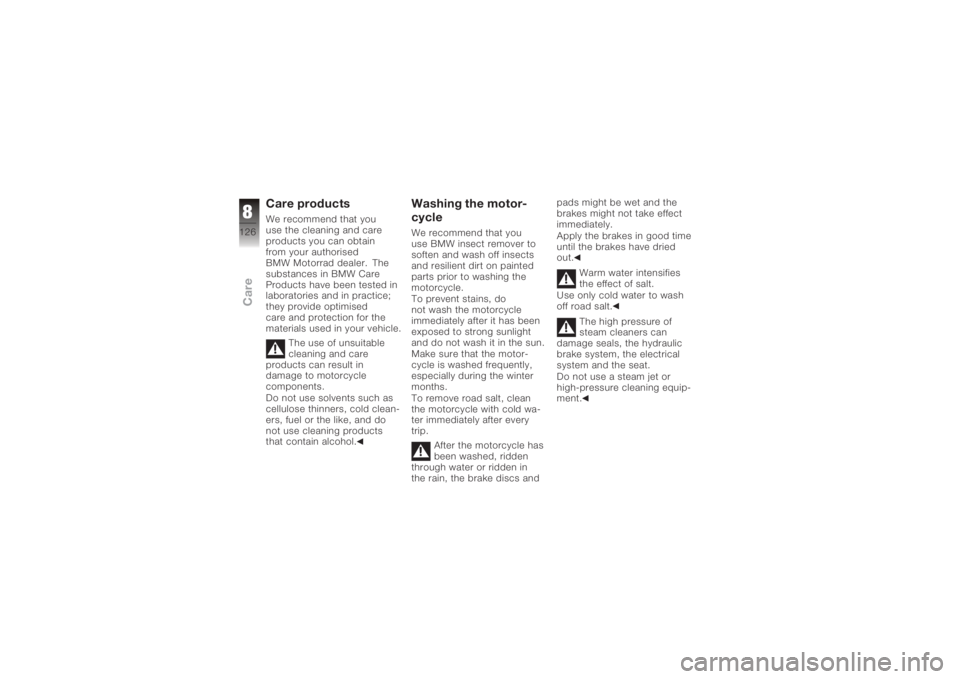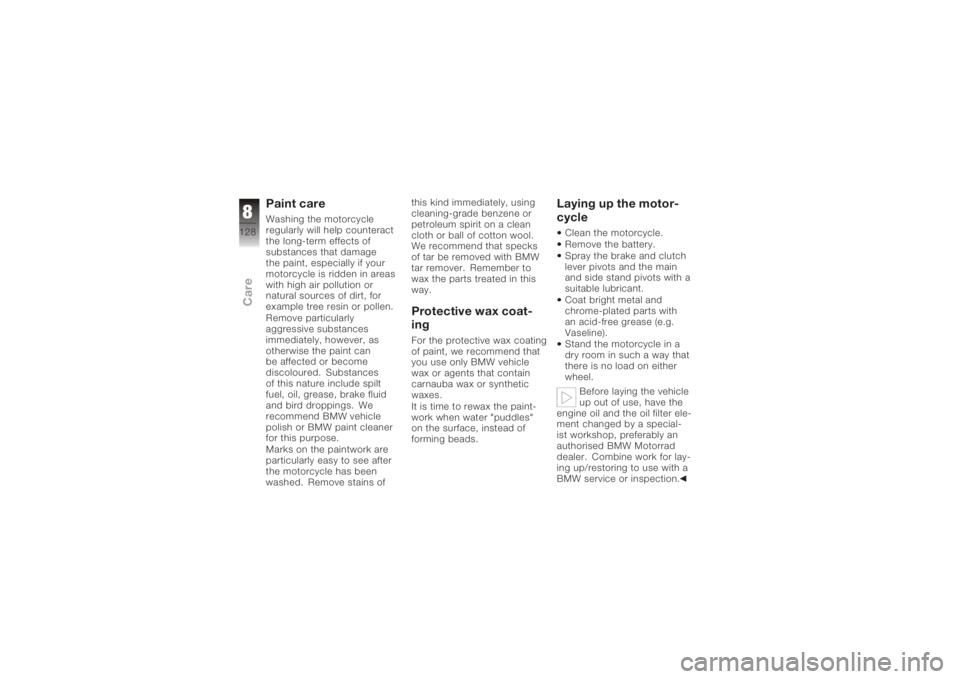Page 118 of 165
Pull the bulb housing for-
ward to remove it and tilt it
slightly down.
Remove bulb holder2from
the headlight housing by
turning it counter-clockwise. Remove bulb
3from the
bulb holder.
Installation of the bulb is the
reverse of the removal pro-
cedure.
Use a clean, dry cloth to
hold the new bulb. The headlight cable
could catch in the
steering if it is not routed
correctly.
Use the appropriate retaining
clips to secure electric wires
at the back of the headlight.
Push the bulb housing into
mounts 4on the frame and
install the securing screws.
Replacing the brake light
and rear light bulbs
If it is not standing firmly,
the motorcycle could
7116zMaintenance
Page 119 of 165
topple in the course of the
operations described below.
Always make sure that the
motorcycle is stable and
firmly supported.Make sure the ground is
level and firm and place the
motorcycle on its stand.
Removing the seat ( 51)
Switch off the ignition.
Remove screw 1. Pull the bulb housing to the
rear until it is clear of hold-
ers
2.
Turn bulb holder 3counter-
clockwise to remove it from
the bulb housing. Press the bulb into
its socket and turn it
counter-clockwise to
remove.
Installation of the brake light
and rear light bulbs is the
reverse of the removal pro-
cedure.
Use a clean, dry cloth to
hold the new bulb.
Replacing turn indicator
bulbs, front/rear
If it is not standing firmly,
the motorcycle could
topple in the course of the
operations described below.
Always make sure that the
motorcycle is stable and
firmly supported.
Make sure the ground is
level and firm and place the
motorcycle on its stand.
Switch off the ignition.
7117zMaintenance
Page 128 of 165

Care productsWe recommend that you
use the cleaning and care
products you can obtain
from your authorised
BMW Motorrad dealer. The
substances in BMW Care
Products have been tested in
laboratories and in practice;
they provide optimised
care and protection for the
materials used in your vehicle.The use of unsuitable
cleaning and care
products can result in
damage to motorcycle
components.
Do not use solvents such as
cellulose thinners, cold clean-
ers, fuel or the like, and do
not use cleaning products
that contain alcohol.
Washing the motor-
cycleWe recommend that you
use BMW insect remover to
soften and wash off insects
and resilient dirt on painted
parts prior to washing the
motorcycle.
To prevent stains, do
not wash the motorcycle
immediately after it has been
exposed to strong sunlight
and do not wash it in the sun.
Make sure that the motor-
cycle is washed frequently,
especially during the winter
months.
To remove road salt, clean
the motorcycle with cold wa-
ter immediately after every
trip.
After the motorcycle has
been washed, ridden
through water or ridden in
the rain, the brake discs and pads might be wet and the
brakes might not take effect
immediately.
Apply the brakes in good time
until the brakes have dried
out.
Warm water intensifies
the effect of salt.
Use only cold water to wash
off road salt.
The high pressure of
steam cleaners can
damage seals, the hydraulic
brake system, the electrical
system and the seat.
Do not use a steam jet or
high-pressure cleaning equip-
ment.
8126zCare
Page 130 of 165

Paint careWashing the motorcycle
regularly will help counteract
the long-term effects of
substances that damage
the paint, especially if your
motorcycle is ridden in areas
with high air pollution or
natural sources of dirt, for
example tree resin or pollen.
Remove particularly
aggressive substances
immediately, however, as
otherwise the paint can
be affected or become
discoloured. Substances
of this nature include spilt
fuel, oil, grease, brake fluid
and bird droppings. We
recommend BMW vehicle
polish or BMW paint cleaner
for this purpose.
Marks on the paintwork are
particularly easy to see after
the motorcycle has been
washed. Remove stains ofthis kind immediately, using
cleaning-grade benzene or
petroleum spirit on a clean
cloth or ball of cotton wool.
We recommend that specks
of tar be removed with BMW
tar remover. Remember to
wax the parts treated in this
way.
Protective wax coat-
ingFor the protective wax coating
of paint, we recommend that
you use only BMW vehicle
wax or agents that contain
carnauba wax or synthetic
waxes.
It is time to rewax the paint-
work when water "puddles"
on the surface, instead of
forming beads.
Laying up the motor-
cycleClean the motorcycle.
Remove the battery.
Spray the brake and clutch
lever pivots and the main
and side stand pivots with a
suitable lubricant.
Coat bright metal and
chrome-plated parts with
an acid-free grease (e.g.
Vaseline).
Stand the motorcycle in a
dry room in such a way that
there is no load on either
wheel.
Before laying the vehicle
up out of use, have the
engine oil and the oil filter ele-
ment changed by a special-
ist workshop, preferably an
authorised BMW Motorrad
dealer. Combine work for lay-
ing up/restoring to use with a
BMW service or inspection.
8128zCare
Page 133 of 165
Technical data
Troubleshooting chart........ 132
Threaded fasteners . . . ........ 133
Engine ....................... 134
Riding specifications . ........ 136
Clutch ....................... 136
Transmission . . . .............. 136
Final drive . ................... 137
Running gear . . . .............. 137
Brakes ....................... 138
Wheels and tyres ............. 138
Electrics . . ................... 139
Frame ....................... 141
Dimensions .................. 141
Weights . . . ................... 142
9131zTechnical data
Page 135 of 165
Threaded fastenersActivityType of threaded connection Tightening
torquesFront wheel
Front brake caliper, wheel carrier
installedM8 x 32 -10.9
30 Nm (Left)
M8 x 32 -10.9 30 Nm (Right)
Clamping screw for quick-release
axle in wheel carrier M8 x 30
19 Nm
Quick-release axle in threaded
bush M24 x 1.5
50 Nm
Rear wheel
Rear wheel to wheel flange M10 x 1.25 (length 40 mm) 60 Nm
Silencer to rear footrest, right M8 x 30 28 Nm
Silencer to manifold M8 - 10.9 self-locking, Optimoly TA 35 Nm
9133zTechnical data
Page 140 of 165
BrakesFront brake, typeHydraulically operated twin disc brake with 4-
piston fixed calipers and floating brake discs
Front brake pads, material Sintered metal
Rear brake, type Hydraulically operated disc brake with
2-piston floating caliper and fixed disc
Rear brake pads, material Organic materialWheels and tyresFront wheel, typeCast aluminium, MT H2
Front wheel, rim size 3.50" x 17"
Front wheel, tyre designation 120/70 ZR17
Rear wheel, type Cast aluminium, MT H2
Rear wheel, rim size 5.50" x 17"
with OE Sports wheel: 6.00" x 17"
Rear wheel, tyre designation 180/55 ZR17
with OE Sports wheel: 190/50 ZR17
Tyre pressures
Front wheel, tyre pressure 2.5 bar, When cold
Rear wheel, tyre pressure 2.9 bar, When cold
9138zTechnical data
Page 142 of 165
Lighting
High-beam headlight bulb, standard designa-
tionH7 halogen bulb
High-beam headlight bulb, voltage 12 V
High-beam headlight bulb, power 55 W
Low-beam headlight bulb, standard designa-
tion H7 halogen bulb
Low-beam headlight bulb, voltage 12 V
Low-beam headlight bulb, power 55 W
Parking light bulb, standard designation W5W
Parking light bulb, voltage 12 V
Parking light bulb, power 5 W
Tail light / brake light bulb, standard designa-
tion P21W
Tail light / brake light bulb, voltage 12 V
Parking light bulb, power 5 W
Front flashing turn indicator bulbs, standard
designation R10W
Front flashing turn indicator bulbs, voltage 12 V
Front flashing turn indicator bulbs, power 10 W
9140zTechnical data